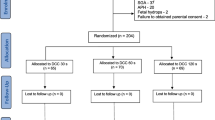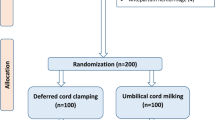Abstract
Objective
To compare the effect of intact umbilical cord milking (MUC) and delayed cord clamping (DCC) on venous hematocrit at 48 (±6) hours in late preterm and term neonates (350/7–426/7 wk).
Study Design
Randomized trial.
Setting and participants
All late preterm and term neonates (350/7–426/7 wk) neonates born in the labor room and maternity operation theatre of tertiary care unit were included.
Intervention
We randomly allocated enrolled neonates to MUC group (cord milked four times towards the baby while being attached to the placenta; n=72) or DCC group (cord clamped after 60 seconds; n=72).
Outcome
Primary outcome was venous hematocrit at 48 (±6) hours of life. Additional outcomes were venous hematocrit at 48 (±6) hours in newborns delivered through lower segment caesarean section (LSCS), incidence of polycythemia requiring partial exchange transfusion, incidence of hyperbilirubinemia requiring phototherapy, and venous hematocrit and serum ferritin levels at 6 (±1) weeks of age.
Results
The mean (SD) hematocrit at 48 (±6) hours in the MUC group was higher than in DCC group [57.7 (4.3) vs. 55.9 (4.4); P=0.002]. Venous hematocrit at 6 (±1) weeks was higher in MUC than in DCC group [mean (SD), 37.7 (4.3) vs. 36 (3.4); mean difference 1.75 (95% CI 0.53 to 2.9); P=0.005]. Other parameters were similar in the two groups.
Conclusion
MUC leads to a higher venous hematocrit at 48 (±6) hours in late preterm and term neonates when compared with DCC.
Similar content being viewed by others
References
Lozoff B. Iron and learning potential in childhood. Bull N Y Acad Med. 1989;65:1050–66.
Stevens GA, Finucane MM, De-Regil LM, et al. Global, regional and national trends in hemoglobin concentration and pre-valence of total and severe anemia in children and pregnant and non-pregnant women for 1995–2011: A systemic analysis of population representative data. Lancet Glob Health. 2013;1:e16–e25.
International Institute for Population Sciences (IIPS) and Macro International. 2007. National Family Health Survey (NFHS-3), 2005–06: India: Volume I. IIPS. Available from: https://dhsprogram.com/pubs/pdf/FRIND3/FRIND3-Vol1AndVol2.pdf. Accessed Jan 10, 2018.
WHO. Guideline: Delayed Umbilical Cord Clamping for Improved Maternal and Infant Health and Nutrition Outcomes. World Health Organization; 2014. Available from: https://www.who.int/nutrition/publications/guidelines/cord_clamping/eng.pdf. Accessed January 10th 2018.
Beyond survival: integrated delivery care practices for long-term maternal and infant nutrition, health and development. II ed. PAHO, 2013. Available from: https://www.who.int/nutrition/publications/infantfeeding/BeyondSurvival2ndeditionen.pdf?ua=1. Accessed Jan 20, 2018.
Jelin AC, Kuppermann M, Erickson K, et al. Obstetricians’ attitudes and beliefs regarding umbilical cord clamping. J Matern Fetal Neonatal Med. 2014;27:1457–61.
Boere I, Smit M, Roest AA, et al. Current practice of cord clamping in the Netherlands: a questionnaire study. Neonatology. 2015; 107:50–5.
Hosono S, Mugishima H, Fujita, et al. Umbilical cord milking reduces the need for red cell transfusions and improves neonatal adaptation in infants born at less than 29 weeks’ gestation: A randomized controlled trial. Arch Dis Child Fetal Neonatal Ed. 2008;93:F14–9.
Rabe H, Jewison A, Alvarez RF, et al. Milking compared with delayed cord clamping to increase placental transfusion in preterm neonates: A randomized controlled trial. Obstet Gynecol. 2011;117:205–11.
Owen DA, Mercer JS, Oh W. Umbilical cord milking in term infants delivered by caesarean section: A randomized controlled trial. J Perinatol. 2012;32:580–84.
Katheria AC, Truong G, Cousins L, Oshiro B, Finer NN. Umbilical cord milking versus delayed cord clamping in preterm infants. Pediatrics. 2015;136:61–69.
Shirk S, Manolis S, Lambers D, Smith K. Delayed clamping vs. milking of umbilical cord in preterm infants: A randomized control trial. Am J Obstet Gynecol, 2019; 220:e1–8.
Jaiswal P, A Upadhyay, Gothwal S, et al. Comparison of two types of intervention to enhance placental redistribution in term infants: Rando-mized control trial. Eur J Pediatr. 2015;17:1159–67.
Yadav AK, Upadhyay A, Gothwal S, Dubey K, Mandal U, Yadav C. Comparison of three types of intervention to enhance placental redistribution in term newborns: Randomized control trial. J Perinatol. 2015;35:720–24.
Moise KJ. Management of rhesus isoimmunization in pregnancy. Obstet Gynecol: 2008; 112:164–76.
Weiner GM, Zaichkin J. Textbook of neonatal resuscitation. 7th edition: American Academy of Pediatrics; 2016.p.12.
Fauvel JP. Hypertension during pregnancy: Epidemiology, definition. Presse Med. 2016;45:618–21.
Singhal PK, Paul VK, Deorari AK, Singh M, Sunderam KR. Changing trends in intrauterine growth curves. Indian Pediatr. 1991;28:281–83.
Ramamurthy RS, Brans WY. Neonatal polycythemia. Criteria for diagnosis and treatment. Pediatrics. 1980;97:118–20.
American Academy of Pediatrics Subcommittee on Hyperbilirubinemia: Management of Hyperbilirubinemia in the Newborn Infant 35 or More Weeks of Gestation. Pediatrics. 2004;114:297–316.
Blood. In: Haneef SM, Maqbool S, Arif MA, eds. Text book of Paediatrics. International Book Bank; 2004.p.545.
Aladangady N, McHugh S, Aitchison TC, Wardrop CA, Holland BM. Infant’s blood volume in a controlled trial of placental transfusion at preterm delivery. Pediatrics. 2006;117:93–8.
Author information
Authors and Affiliations
Corresponding author
Additional information
Ethics clearance
Institute Ethics Committee, AIIMS; No. IECPG/197/24.02.2016, RT-10, dated March 30, 2016.
Contributors
MKM: protocol development, study implementation, data management and writing the manuscript; AT, MJS: development of the protocol and supervised implementation of the study and contributed to writing of the manuscript and did data analysis; VKP, AKD, RA: protocol development, and provided critical inputs in manuscript writing. All authors approved the final version of manuscript, and are accountable for all aspects related to the study.
Funding
None
Competing interests
None stated.
Rights and permissions
About this article
Cite this article
Mangla, M.K., Thukral, A., Sankar, M.J. et al. Effect of Umbilical Cord Milking vs Delayed Cord Clamping on Venous Hematocrit at 48 Hours in Late Preterm and Term Neonates: A Randomized Controlled Trial. Indian Pediatr 57, 1119–1123 (2020). https://doi.org/10.1007/s13312-020-2064-7
Received:
Revised:
Accepted:
Published:
Issue Date:
DOI: https://doi.org/10.1007/s13312-020-2064-7




